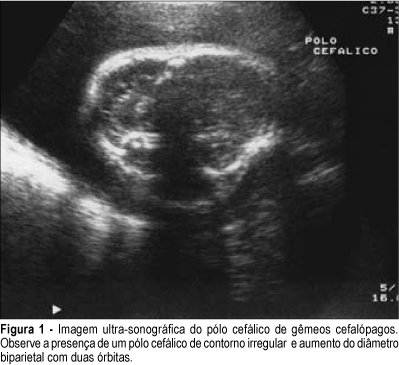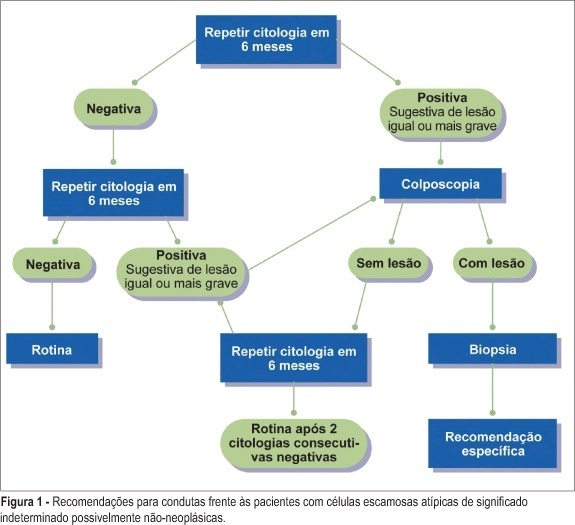Summary
Revista Brasileira de Ginecologia e Obstetrícia. 2006;28(7):416-423
DOI 10.1590/S0100-72032006000700007
Conjoined twins have a rare prevalence and special curiosity among physicians and the general population. The reported frequency varies from 1:50,000 to 1:200,000 pregnancies. Its early diagnosis becomes very important when we think about pregnancy management, method of delivery and neonatal care. We describe two cases of conjoined twins diagnosed by ultrasound and magnetic resonance during prenatal care with the aim to better studying the fetus anatomy. The first conjoined twins were cephalopagus sharing head, thorax and abdominal wall and with two pelvis and four arms and four legs. The second were thoracopagus, united by thorax and part of abdomen. Magnetic resonance imaging contribution was not important to diagnose conjoined twins. However, it was useful to describe the shared organs, contributing to define fetal outcome.

Summary
Revista Brasileira de Ginecologia e Obstetrícia. 2006;28(7):410-415
DOI 10.1590/S0100-72032006000700006
PURPOSE: to verify, through pelvic ultrasound, the existence of changes in the internal genitalia of girls with central precocious puberty, submitted to treatment with gonadotrophin-releasing hormone (GnRH) analogs. METHODS: pelvic ultrasound was performed in 18 girls with idiopathic central precocious puberty, before and after three months of onset of the treatment with GnRH analogs, to investigate the impact of the therapy on the internal genitalia. Ovarian and uterine volumes, uterine longitudinal length, relation between the longitudinal diameter of the uterine corpus and the uterine cervix, the relation between the anterior-posterior diameter of the uterine corpus and the uterine cervix, and endometrial echogenicity were evaluated. Statistical analysis was performed through Shapiro-Willkis's test, to assess data normality. When normality was present, Student's test t was applied. For data without normality, a non-parametric test (the signal test) was used. RESULTS: after therapy, statistically significant decline of the mean uterine volume (from 5.4 cm³ to 3.0 cm³, p<0.001), of the mean ovarian volume (from 2.2 cm³ to 1.1 cm³, p= 0.004), of the mean uterine longitudinal length (from 4.2cm to 3.4 cm, p=0.001), and of the mean endometrial echogenicity (from 1.8 mm to 0.6 mm, p=0.018) occurred. CONCLUSION: In girls with idiopathic central precocious puberty, pelvic ultrasound is a valid method to assess the efficacy of treatment with GnRH analogs. The main parameters of the therapeutic response were the decrease of uterine and ovarian volume, of uterine longitudinal length, and atrophy or absence of endometrial echogenicity.
Summary
Revista Brasileira de Ginecologia e Obstetrícia. 2006;28(7):403-409
DOI 10.1590/S0100-72032006000700005
PURPOSE: to compare in a retrospective way, 51 women who underwent tubal ligation, 30 through microlaparoascopy (Gmicrol) and 21 through minilaparotomy (Gminil). METHODS: the analyzed parameters were: total time for accomplishment of the procedure and the surgical technique, time of hospital stay and return to the habitual activities after the surgery, postoperative pain, morbidity, satisfaction degree and esthetic effect, considering values of p<0,05 as significant, and also standard cost. RESULTS: Gmicrol took less time to accomplish the surgery than the Gminil (43 against 57 minutes respectively, p<0,05), less time to accomplish the surgical technique (6.48 against 30.32 minutes respectively, p<0,05), and lower hospital stay (9,90 hours as against 41,7 hours respectively, p <0,05). There was no significant difference between the two groups regarding time to return to the habitual activities after surgery. To evaluate postoperative pain, a scale of 0-10 it was applied. Gmicrol present a lower pain score on the 1st and 2nd postoperative days (1.13 and 0.26 to Gmicrol and 4.52 and 1.14 to Gminil, respectively, p<0,05). There was no significant difference between immediate postoperative the most common complaint being pain at the site of pain and that on the 3rd postoperative day. Gminil presented a higher morbidity rate incision. To evaluate the satisfaction degree and esthetic effect, numeric values were attributed to as good, regular, poor and very bad as answered by the patiets. Gmicrol presented a higher satisfaction degree (p<0,05) and better esthetic effect as compared to Gminil (p <0,05). The microlaparoscopy standard cost was R$ 109.30 being lower than that of minilaparotomy. CONCLUSIONS: tubal ligation by microlaparoscopy, under local anesthesia and conscious sedation presented some advantages compared to minilaparotomy.
Summary
Revista Brasileira de Ginecologia e Obstetrícia. 2006;28(7):397-402
DOI 10.1590/S0100-72032006000700004
PURPOSE: to compare the uterine cervix measurements and funneling obtained by two- and three-dimensional transvaginal sonography during pregnancy. METHODS: a prospective, descriptive study, with group comparison, was carried out between April 2004 and February 2005 in 74 pregnant women, who were between the 19th and 24th week of pregnancy, regardless of risk factors for premature delivery. The ultrasound examination of the cervix was carried out only once in the same patient and by only one observer. The measurements of the cervix by two-dimensional ultrasound were made at the time of the test and by three-dimensional ultrasound at intervals of 7 to 15 days after the two-dimensional ultrasound. The measurements of cervical length, funnel width and length were taken by two-dimensional ultrasound in the sagittal plane and by three-dimensional in the sagittal plane as well as in coronal plane. RESULTS: there was no significant difference between the averages of the measurements of the cervix obtained by two- and three-dimensional ultrasound in the sagittal plane (p=0.23); however, there was a difference in the averages of the measurements of the cervix obtained by two-dimensional ultrasound in sagittal plane and three-dimensional ultrasound in the coronal plane (p=0.009) and between three-dimensional ultrasound in the sagittal and coronal planes (p=0.001). The kappa test (0.86) showed no superiority of either the two-dimensional and three-dimensional ultrasound in the visualization of the cervical funnel. No statistically significant difference was observed between the methods when the average of the measurements of funneling was compared (p>0.05). CONCLUSION: there were differences between two-dimensional and three-dimensional ultrasound of cervical length, only using the coronal plane of the three-dimensional ultrasound.
Summary
Revista Brasileira de Ginecologia e Obstetrícia. 2006;28(7):388-396
DOI 10.1590/S0100-72032006000700003
PURPOSE: to generate knowledge in order to allow of the determination the factors affecting the high incidence of caesarean section and its relation to sterilization. METHODS: the multicentric study on reproductive health in Brazil, carried out from 1998 to 2000, included the States of Rio Grande do Norte, Minas Gerais, São Paulo, and Rio Grande do Sul. It was characterized as a longitudinal study, where the women, proceeding from public as well as private health services, were interviewed at three moments: at the beginning of pregnancy (until the 22nd week of gestation), at the end of pregnancy (between 30 and 40 days before the probable date of childbirth) and after delivery (between 15 and 45 days after childbirth). The interviewed women complied with the following eligibility criteria: to have 18 to 40 years of age, to live in Natal and plan to deliver the baby in Natal. At the first moment, 433 women were interviewed, 380 at the second moment and 269 at the third moment. The data were submitted to the chi-square test, with the level of significance set at 0.05, just to assure the relation between the variable years of schooling (0 to 8 and 9 or +) and the representative variables for reproductive health. RESULTS: the result disclosed a statistically significant relationship (p<0.05) between the variables: years of schooling, parity, type of service used, social class, job status, and prenatal consultations. It was found that a higher educational level is predominant among those women who searched for private services, coming from higher social classes and large number of prenatal visits. Although without statistical significance, having a for the women coming from this type of service, a higher number of caesarean section5 was observed, probably due to an easy doctor-patient interaction, while the planned caesarean section was frustrated for 43% of those women coming from public health services, as well as the wish to have a tubal ligation at childbirth (57%). CONCLUSIONS: These results show up the great differentials between the private and public services, with a clear favoritism for the private sector, demonstrating clearly that the practical obstetrics in Brazil needs a change and an improvement both for those women with access to the private service, who obtain the accomplishment of the caesarean section without consistent medical indications, and those with access to the public service, who face difficulties in accomplishing this procedure, even with consistent medical indications, in order to provide equality in the reproductive rights of those women.
Summary
Revista Brasileira de Ginecologia e Obstetrícia. 2006;28(7):380-387
DOI 10.1590/S0100-72032006000700002
PURPOSE: to evaluate all maternal deaths that occurred between 1927 and 2001, among 164,161 patients admitted to the Maternidade Therezinha de Jesus, the obstetrical service of the "Universidade Federal de Juiz de Fora", Brazil. METHODS: a retrospective study of 144 maternal deaths that occurred in the maternity hospital in 75 years, with 131,048 live births in the same period of time, analyzing all patients's records regarding their clinical history and data from death certificates. Autopsies were not performed. Data obtained were age, parity, gestation length, complications, moment, and causes of death. The index of maternal mortality (IMM) period 100 thousand live births was utilized. For statistical analysis the chi2 test and the exponential smoothing technique were used (alpha=0.05). RESULTS: IMM decreased from 1544 in the period 1927-1941 to 314 (p<0.001) between 1942 and 1956 and from 1957 to 1971 it was reduced to 76.4 per 100 thousand live births (p<0.001). Nevertheless, since 1972 there was no further significant improvement (IMM=46 in the last 15 years, p=0.139). Maternal mortality was more frequent in the 15 to 39 years age group, in nulliparous patients with term pregnancies and mostly in the immediate postpartum period (53%). Direct obstetric causes occurred in 79.3% and indirect causes in 20.7% of the cases. Analyzing the evolution of the causes of death, it was found that in the first period of time the most frequent direct obstetric causes in descending order were puerperal infection, eclampsia and uterine rupture, while in the second period they were prepartum hemorrhage and eclampsia, and from 1977 to 2001 hemorrhage, abortion and preeclampsia. Analysis of the past 15 years showed the absence of maternal deaths by either preeclampsia or puerperal infection and the main causes were peripartum hemorrhage, abortion and indirect obstetrical causes. Relating maternal mortality to the type of delivery by the relative risk between cesarean section and vaginal delivery, it was found that when the indication of cesarean section is inevitable its risk is lower (relative risk = 0.6) than through vaginal delivery. CONCLUSIONS: despite the reduction along the 75 years of study, maternal mortality of 46 per 100,000 live births is still very high, and there was no significant decrease since 1972. Many deaths are avoidable. Hemorrhage is at present the most frequent cause of maternal death, the decision to intervene should be fast, and a proper indication for a cesarean section is a safe option. Maternal mortality caused by abortion is increasing alarmingly and family planning is essential.
Summary
Revista Brasileira de Ginecologia e Obstetrícia. 2006;28(8):486-504
